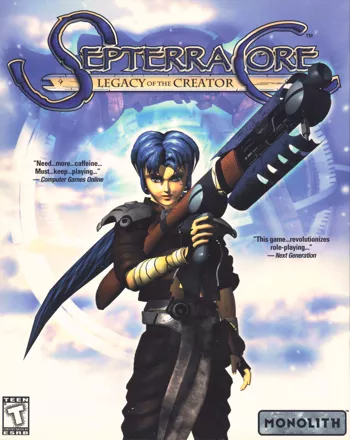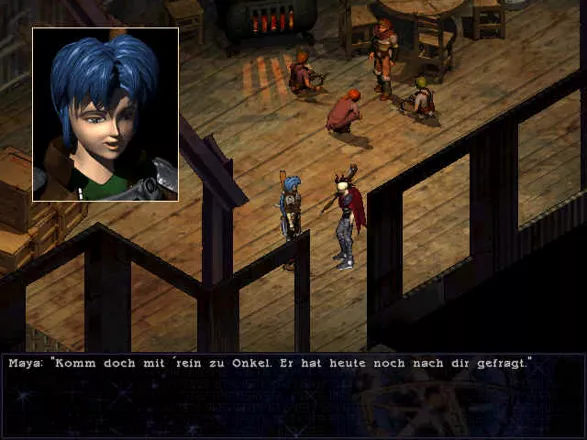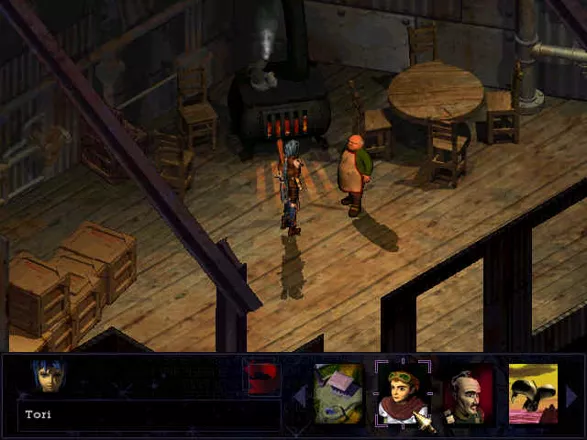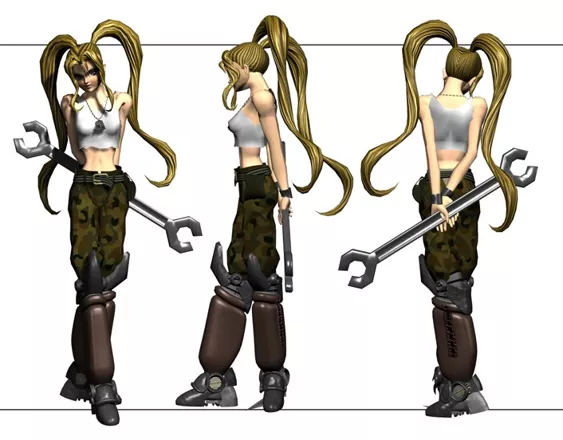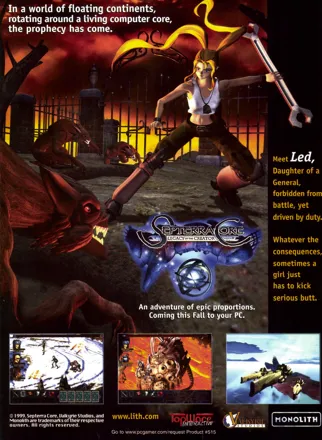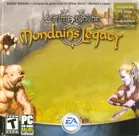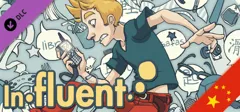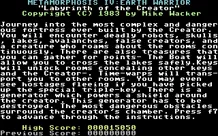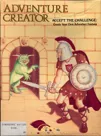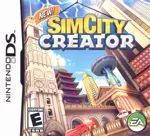Septerra Core: Legacy of the Creator
Description official descriptions
Septerra is a world which is composed of "layers" - continents that spin around the planet center. In the center is the Core, a kind of a living computer. According to the legends, the Creator of Septerra left there a precious Gift - an artifact that grants the one who possesses it legendary powers. Septerra is controlled by the Chosen, who live at the top of the world, consuming massive amounts of energy and throwing the "waste" down, to lower levels. Maya, a "junk scavenger" who lives among those wastes and earns the living collecting junk, unexpectedly comes into contact with the Chosen. It appears that their goal is to reach the legendary Gift. Maya and her friends decide to face the Chosen, and ultimately discover the true history of the planet.
Despite its Western origins, Septerra Core is a Japanese-style role-playing game. The game's visual design is close to Japanese anime, and the emphasis of the game is on a character-driven linear narrative with simple role-playing mechanics. The game's story evolves across the seven worlds of Septerra, each with its own distinct style, including post-apocalyptic, semi-medieval, futuristic, etc. In the first half of the game the player-controlled party explores these worlds on foot, accessing towns and other areas from an overworld. Later the player gains a ship that allows fast transportation to any world, including previously inaccessible areas.
Combat is turn-based and takes place against enemies who either visibly wander around or appear at pre-set locations in hostile areas. There are no enemies on the world map. The action bar of each character is divided into three segments and is gradually filled. Opting for either fast and weak or strong and slow attacks, the player must select a character in real time, stopping the bar and pausing combat. Magic spells are usually awarded after completing plot events and may be combined with each other by two or three characters to create new ones. The player is for the most part free to form a party of three active combatants from a larger cast.
Spellings
- 赛普特拉战记:创世神话 - Simplified Chinese spelling
Groups +
Screenshots
Promos
Videos
Add Trailer or Gameplay Video +1 point
See any errors or missing info for this game?
You can submit a correction, contribute trivia, add to a game group, add a related site or alternate title.
Credits (Windows version)
248 People (141 developers, 107 thanks) · View all
| Producer | |
| Designer/Creator | |
| Art Production Director | |
| Original Concept | |
| Programming - Game Engine, Tools | |
| Programming - Terrabuilder | |
| Story/Script/Level Design | |
| Programming - Sound | |
| Character Design/Concept Sketches/Story Board | |
| Art & Animation | |
| Terrabuilders | |
| [ full credits ] | |
Reviews
Critics
Average score: 74% (based on 40 ratings)
Players
Average score: 3.8 out of 5 (based on 27 ratings with 4 reviews)
Valkyrie Studios did a good job with Septerra Core. Albeit, they didn't do a great job.
The Good
Septerra Core has a fantabulous story. A super-extra-frosted good story. It's got a man bent on world destruction, secret motives, believable characters packaged into a surprisingly original environment. Graphically, Septerra Core may not take your breath away, but it will surely interest you. The setting changes frequently throughout the game, so at times you'll be playing a dank, dark dungeon crawl, at other times you'll be wandering about in a humid jungle full of mutants. Eventually, one of those mutants even joins your party. It features a very console like combat system, which turns out to be a mixed bag. On one hand, the game has a very interesting spellcasting system. Your character, Maya, will gradually collect "fate cards" as the game progressives. Using one fate card might have a certain effect, such as casting a minuscule fire spell. Combining this fire fate card with another fate card that might, say, cause the character to toss a grenade, will create an all new spell that launches a flaming napalm grenade. Sound interesting? It is, but unfortunately, even the games best ideas are bogged down by the games agonizingly slow combat system.
The Bad
The games combat system is, in a word, boring. A word probably isn't clear enough of a description, so lets elaborate. Imagine yourself playing Final Fantasy VIII. If you remember, casting a summon spell would trigger a lengthy animation, which, while impressive at first, was really, really long and wasn't very fun the third time. Septerra Core's attack animations are much the same, only they were never spectacular to begin with. A character that isn't fortunate enough to possess a ranged attack will jump in a goofy looking rainbow arc to their foe, pause a moment, hit their enemy, pause another moment, and leap back to their original position. There's nothing too wrong with this on paper. Factor in that each animation can take up to 2.5 seconds. Now factor in that there are usually at least 5 hits to go around in a short skirmish for your party alone. The typical combat sequence goes like this: character walks into monster. Game screen shifts to a more suitable position to view the fight. Monster starts off by shifting his feet, and then slowly raising his arms to pummel one of your characters. Then, whilst uninteresting music plays, your character slowly leaps over to the monster to return the favor. It's a good bet that you've already lost interest. Despite having great ideas, an engaging story, and pretty decent graphics, Septerra Core drags itself out needlessly via its slow, cumbersome battle system.
The Bottom Line
Septerra Core isn't exactly a missed opportunity, but it's very close. You'll probably have a lot of fun playing Septerra Core, but you might want to rediscover a tomagachi to keep yourself occupied during the battles. Best compared to watching giant pandas. They're cute, cuddly, and fun, when they aren't sleeping. The problem with pandas is that they sleep 50% of the day. When it comes down to it, I'd recommend Septerra Core. At the price it goes for nowadays (bundled with Shogo, even), you're going to get your moneys worth for sure. Just don't say I didn't warn you.
(Interesting note: Valkyrie was working on another game called "Seraphim" where flying angels beat the snot out of each other with their divine powers. The game fell through because they couldn't find a publisher.)
Windows · by WJAndrews (32) · 2004
Passionate and flawed tribute to the Orient
The Good
Septerra Core is a role-playing game in Japanese style made by American developers - a rare and odd phenomenon, considering the almost diametrically opposed RPG design philosophies of East and West. Shortly after Fallout and Baldur's Gate invigorated the Western RPG genre and Final Fantasy VII turned Eastern RPGs into blockbusters with cutting-edge technology, Septerra Core attempted to imitate the Japanese style while borrowing a few ideas from its Western brothers.
Conceived entirely as an homage, without any groundbreaking ideas or technology to back it, Septerra Core really depended on how much feeling and effort the designers were willing to put in it. Fortunately, their passion truly ignited the game, turning a modest effort bordering on fan fiction into a lovingly crafted title that falls short of greatness largely for mechanical reasons.
Despite its anime-like aesthetics and strict adherence to the Japanese formula, Septerra Core still has something that betrays its American origins. These are mostly small features, but adding them together gives the game a significant boost. My number one feature is probably NPC interaction. I don't recall another Japanese-style RPG where you could actually select conversation topics. Rudimentary compared to contemporary Western RPGs, they are still heaps and bounds above the dialogue systems of the East. Not only that, but selecting different player-controlled characters to talk to NPCs may lead to unexpected results such as unique dialogue lines. Many of these are completely optional and hence give the game a light flavor of freedom so lacking in Japanese RPGs. One of the most enjoyable activities for me was scouting a new city for NPCs and just chatting with them, disregarding the main story. I've always had a soft spot for conversation-rich RPGs, and this is certainly one of them. Also, every single line of dialogue in the game is voiced.
Another interesting feature are inventory-based puzzles. There aren't many of them and they are very simple, but I really liked that nod to Western adventure games of yore. You'll actually have to think and figure out what you need to advance, which often involves carefully listening to what NPCs tell you and hunting for clues. It's details like this that differentiate Septerra Core from its countless comrades in a genre where making a generic world map with towns and dungeons and slapping some turn-based combat on them was in many cases a sufficient reason for publishing an RPG. You always feel that every element of the game was crafted with care and dedication.
Instead of being set in one world, Septerra Core has seven of them. Make no mistake - those are really worlds, even though they are connected to each other and are part of one system. The striking difference between the worlds is what makes this setting so cool. You'll start on a post-apocalyptic Shell 2, in a deserted world with heaps of junk and people living among them. You'll complete one quest in this world, leave it, and the setting will change drastically. You are on Shell 3, which is a medieval-like society complete with old-fashioned towns, green grass fields, and knights fighting with swords. You leave Shell 3 and arrive in a modern society where two countries wage war, using weapons of massive destruction. And before you notice it, you are on the weird Shell 7, where nobody lives but the mysterious tribe of the Underlost, but where strange plants and mushrooms grow to form a gigantic mold forest just near the lava mountains.
This setting keeps you interested even at times when the story fails to do the same. The variety of locations is astonishing. Septerra Core is heavy on dungeon exploration, but you'll never feel the dungeons are repeating themselves. From the snow mountains near Armstrong to the futuristic Ankaran research lab, from the spooky graveyard to the colorful mold forest, from the subway tunnels to the claustrophobic Chosen palace - you'll be constantly switching environments that form a maximal contrast to each other. You are not tied to the same standard setting, but at the same time, each individual setting is convincing and engrossing in its own way. You'll be immersed by the plains around Wind City just the same way as by the sleazy World Bazaar with its Slums and Red Light District.
The setting comes to life thanks to beautiful graphics. Septerra Core looks a lot like Planescape: Torment or any other isometric RPG that comes to mind: small pre-rendered character models over pre-rendered backgrounds. While the characters could have used more work, the backgrounds are full of detail and sometimes can be atmospheric and immersive in a nearly magical way. In general, the visuals are almost impeccable and in fact better than in many real Japanese RPGs of the time.
The combat system in Septerra Core has its bright sides. The addition of the quasi-real-time element makes it more spicy than usually, and teaming up to discover new magic spells can get quite rewarding. Some of the enemies are pretty cool, and a special praise goes to boss battles. The bosses are for the most part tricky guys whom you cannot defeat simply by unleashing your most powerful attacks. There is often some sort of a puzzle surrounding a boss. This is much more interesting than simply hacking away without thinking. I enjoyed very much such encounters as for example the battles against the colored Magi in the Chosen palace. And of course, any game that eschews random battles automatically receives extra points for doing that.
I think Septerra Core is one of the very few games in its genre that handle the difficulty level just right. If you found its contemporary Final Fantasies too easy you can count on challenge in this one. However, this challenge is also far remote from "fight 5864 more enemies and gain 7 more levels to be able to survive the next boss battle" of earlier Japanese RPGs. Equipment preparation, party management and tactics are more important than your levels here. The party is well-balanced and the system manages to find the middle ground between old-school classes and the new fashion of characters with identical stats that can do anything at any time.
The characters are unfortunately not that interesting, but at least the game's Western creators didn't feel obliged to include a pink teddy bear or something like that to occupy the customary "kawaii" spot.
The Bad
There are all sorts of negative little things that impede the enjoyment almost the same way as the positive little things I mentioned above enhance it. These may include stiff voice acting, occasional bad writing that makes following the story less interesting at times than just chatting with NPCs, palette-swapping enemies, excessively repetitive NPC portraits, wooden animation, a few interface-related weirdnesses, and so on. But nothing comes as close to ruining the game as the combat.
You see, there is nothing wrong with the battles of Septerra Core, but there is also nothing exciting in them. While Final Fantasy VII had spectacular shows with all sorts of explosions and other eye candy, and Western RPGs had depth and dynamics that compensated for the lack of effects, Septerra Core has neither. It has vanilla Japanese RPG combat where tiny people exchange pitifully-looking attacks until some of them drop dead. Worse, however, is the fact that battles take way too much time. There is a ridiculous leaping animation in the beginning of every single battle, and then you'll have to wait for the bars to fill. Enemies are often speedier than you and the game rarely allows you to get rid of them quickly. A fan patch adds a queuing command that at least reduces micro-management somewhat, but you'll still have to spend precious minutes staring at painfully uninteresting screens. Near the end of the game abusing powerful magic helps things a bit, but the first half is spent with a way too limited arsenal that never gives you the satisfaction of simply shredding your foes to pieces at once if you want to.
Dungeon design doesn't help to alleviate those annoyances at all. Even though there are no random enemies you can hardly ever avoid combat, and enemies blocking narrow passages will quickly become a recurrent sight. Most of the dungeons are designed in such a way that you have to flip switches or hunt for keys all the time. It is okay one time, but it becomes quite tedious when you have to do it in every single damn dungeon you enter. There is generally way too much backtracking in the game, you often have to exit huge areas by yourself and spend too much time running around where you have been before, fighting the same pre-set battles over and over again. This tedium is there for pretty much the entire game. The dichotomy between the graphical beauty of the dungeons and their uninspired structure creates strange hesitation, making you want to press forward to see how the next location looks like and at the same time quit the whole thing and catch some fresh air.
The story is very typical, featuring stuff like ancient prophecies, cosmic battles, a mysterious artifact, evil imperial general, and so on. Nothing wrong with that, but we've seen this stuff before and the writing does little to distinguish it from the many parallel examples within the genre. There is little extravagance in the plot and it's very predictable from the beginning to the end, so those hungry for improbable twists and Freudian traumas will be disappointed.
There is generally something stiff and almost awkward in the way the story of Septerra Core is presented. It is as if the writers tried to make it Japanese but were afraid or incapable of going all the way with that. Thus, the story emulates plot devices and outward characteristics of Japanese anime and video games, but is unable to truly reflect its spirit. This may constitute the game's biggest flaw for those who play Japanese RPGs mostly for the emotions. This is not to say that the story of Septerra Core lacks emotional moments, but they are badly delivered. Even though there are plenty of dramatic situations in the game, their impact is lessened because the characters fail to react adequately. Have you seen Layla after her father was killed? If Septerra Core were made by the Japanese, Layla would fall on the ground and weep bitterly, accompanied by touching Celtic tunes. In this game she just mumbles a few dry and unconvincing lines, ruining the moment and severing any emotional connection you might have begun to have with her.
It's even hard to care for your companions under such conditions: whenever you start feeling something warm they repel you with their indifference. We are hence forced to switch to an old-school mode where playing games with little characterization required us to create their personalities ourselves and invent our own fictional scenarios where they would be more prominently featured. The game also lacks dramatic presentation, with only a few cinematic cutscenes and no effects whatsoever during non-interactive events made with in-game engine. This would be absolutely fine in a Western RPG, but playing a Japanese-style RPG with little emotionality and drama is like eating a pizza without cheese.
The Bottom Line
There is plenty to love in Septerra Core, and unfortunately also plenty to dislike. A Japanese-style RPG devoid of goofy emotionality and flashy gameplay gimmicks quickly reveals schematic, outdated gameplay that is hard and ultimately pointless to deal with, especially when it's also slow and tedious. No matter how much thought was put into designing the game world, it's difficult to appreciate it when the actual game stands in your way.
Windows · by Unicorn Lynx (181780) · 2014
Excellent RPG - a questing adventure with a twist
The Good
I must admit that I've played some really good RPGs over the last year or two -- and this is definitely among that group.
In a nutshell, Septerra Core has all the features I like:
- An In-depth and Unique Story
- Diverse, Interesting Characters
- Loads of Unrepetitive Dialog
- Dungeon-like Questing
- A Multitude of Worthy Opponents
- Various World Environments
- Pleasing Graphics, Music and Sound Effects
**The Bad**
I really enjoyed everything about Septerra Core, so consider the following to be "weaknesses" instead of real dislikes.
**The Bottom Line**
This game is fun! If story is primary, and you enjoy role playing games with loads of adventuring, Septerra Core is a must for your collection. Not only will it take you a long while to finish, the characters and plot will stay with you long afterwards. A memorable experience, to be sure. It is a real shame that Valkyrie Studios folded .. I would've liked more from them.
Windows · by Jeanne (75945) · 2004
Trivia
Character names
The game's lead character "Maya" was not named after the 3D animation software of the same name. Maya the character was named before Maya the software was released, while the game was still gestating at Viacom New Media in 1997 (Alias/Wavefront released Maya in 1998).
However, many of the names of characters and places in the game do have some significance to the team -- Princess Alisa is named for lead artist Alisa Kober, for example, and the town of Pranno is named after Digger Penbrook.
Cut ending
Also, there exists somewhere among the computers of current and former Valkyrie persons a special end credit sequence -- the "Benny Hill" ending (I can't really describe it, you kind of have to see it ). We've talked about putting out a patch for it, and maybe one day we will. I'm sure the seven or eight people who actually bought and played this game would get a kick out of it. :)
Awards
- GameSpy
- 1999 – Special Award for Story (together with Nocturne)
Analytics
Upgrade to MobyPro to view research rankings!
Related Sites +
-
Game Solves Walkthrough
One of the most complete solutions on the net for this game. -
Junker's Paradise: A Septerra Core Fansite
Fansite with info, downloadable material, walkthroughs, FAQ, save files, patches, interviews with the developers, fan forum and more. -
The Core Factor
An excellent and up-to-date source for Septerra Core news and info.
Identifiers +
Contribute
Are you familiar with this game? Help document and preserve this entry in video game history! If your contribution is approved, you will earn points and be credited as a contributor.
Contributors to this Entry
Game added by DarkTalon.
Linux added by Iggi. Macintosh added by me3D31337.
Additional contributors: Unicorn Lynx, Jeanne, mrpenbrook, chirinea, CaesarZX, Patrick Bregger.
Game added January 3, 2000. Last modified April 3, 2024.
